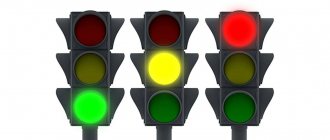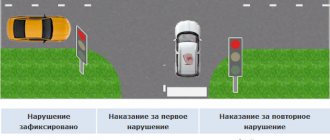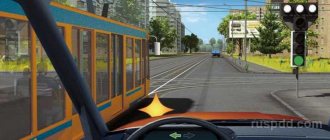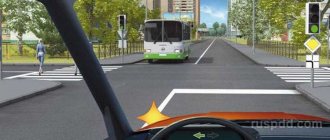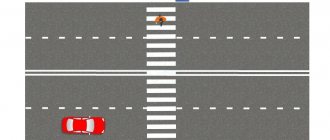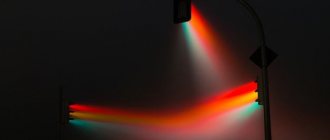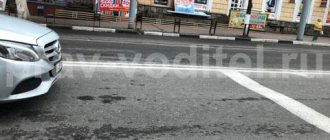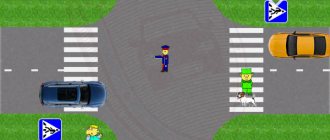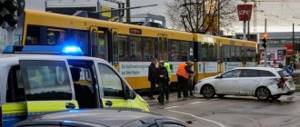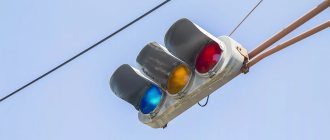The first traffic light in history was installed in 1868 in London. Traffic control on the roads was carried out using two arrows: if they were in a horizontal position, passage was prohibited, but in the case of a vertical position it was allowed. The mechanism was controlled by a specially trained person. An automatic traffic light, as close as possible to a modern one, was created in the USA in 1914. It consisted of two colors - red and green. Later the device was supplemented with yellow color.
Modern traffic light: what colors provide traffic control
You may be interested in: Methods of paying traffic fines at Alfa-Bank. Payment of fines through ATMs and payment terminals
Currently, the device is an aluminum or plastic case, inside of which LED matrices are located. Their service life is approximately five years. Sometimes you can find traffic lights based on incandescent lamps. They are less durable and are already an outdated set for traffic lights.
Modern devices are controlled by a carefully developed automated program that is capable of simultaneously controlling the operation of a large number of data lighting devices. There are three traffic light colors: red, green and yellow. Each of them has a specific meaning.
Types of traffic lights
The classic traffic light is three-color with round lamps: red, orange and green. Usually they are located vertically, but on wide multi-lane highways horizontal ones are used.
Road and pedestrian traffic lights
There are more types of road traffic lights, since transport has a higher variability of movement than pedestrians. Types of transport traffic lights have the following purposes.
- Traffic lights with arrows pointing in one or more directions. They allow movement in the appropriate direction.
- Traffic lights with arrows pointing in the direction of travel (up). They are used in cases where traffic following their signal is not intersected by other traffic flows (practically not found in the post-Soviet space).
- There may be smaller versions of road traffic lights that are similar in meaning. They are used as auxiliary ones (duplicate the signal) when the main traffic light is difficult to see.
- Horizontal traffic light display consisting of several screens. Used to allow or prohibit movement in one or more lanes during reverse traffic. Also installed near tunnels. The designation of a prohibiting signal is usually an oblique cross, and a permitting signal is usually an arrow.
- Traffic lights for traffic in a dedicated lane.
- Traffic lights at railway crossings.
- Special traffic light with one yellow signal. Signals that there is an uncontrolled intersection or pedestrian crossing ahead.
- Traffic light with two signals. It is installed in places where the road narrows (usually during its repair) and where reverse traffic is introduced.
Traffic lights for pedestrians usually have two signals. Often the signal looks like a stylized picture of a walking or standing person.
Railway traffic lights
Railway traffic light signals are intended for drivers driving trains. The types of traffic lights on the railway have a richer color range. In addition to standard colors, the driver leading the train also receives information from blue and white traffic lights, as well as their various combinations.
For a motorist when crossing railway lines, there is a general principle: green means “you can go” and red means “you can’t go.”
Red traffic light
Everyone knows that red is an aggressive, exciting, flashy color. It means danger. In a traffic light, red is prohibitive. Even in kindergarten, children are taught: “The color red means no movement.”
For road users, a red traffic light indicates that driving beyond the stop line is prohibited. All cars without exception must adhere to this rule unquestioningly. Traffic rules provide for penalties for driving through an intersection with a prohibiting traffic light. These fines are quite large and deserved, because running a red light can be very dangerous. It is because of irresponsible drivers that sometimes the most terrible accidents occur at traffic lights and intersections.
The red color is very visible in any weather: when the sun is shining brightly, it is raining, or there is fog. From a physical point of view, red has the longest wavelength. This is probably why it was chosen as forbidden. The meaning of red is the same all over the world.
Arrows and arrow sections
An additional section is included that allows turning to the right, while other traffic participants have the advantage of passing through the intersection, traffic in other directions is prohibited
When the main traffic light with a black arrow is turned on, it allows movement only straight; turning left is carried out only with a signal from the additional section of the traffic light.
Traffic light signals can be represented by colored arrows on a dark background, or contour arrows are applied to the main signals, and a traffic light can also have additional sections in the form of arrows or arrow outlines that regulate traffic in one direction or another.
Thus, in the traffic rules of the Russian Federation in paragraphs 6.3, 6.4 and 13.5 the following options are described:
- Traffic light signals are represented by colored arrows (red, yellow, green)
- the signal applies only in the direction of movement indicated by the arrow (a green arrow to the left also allows a turn if it is not prohibited). Examples: a traffic light only regulates the direction of movement to the right; an illuminated signal with a green arrow allows turning only to the right; the traffic light regulates only the direction of movement to the left, the switched on signal with a red arrow prohibits turning only to the left (from these lanes, according to road signs, only left turns are allowed); the traffic light regulates only the direction of movement to the left, the effect of the switched on signal with a yellow arrow applies only when moving to the left (from these lanes, according to road signs, only left turns are allowed); The traffic light only regulates the direction of movement straight; when the signal with a green arrow is turned on, it allows movement only straight. - the green traffic light signal has a black contour arrow(s)
- it notifies that this is the main traffic light signal and the traffic light has an additional section, the effect of the main signal extends only in the directions indicated by the contour arrow. Examples: when the main green traffic light with a contour arrow is on, it only allows straight ahead traffic; traffic in other directions is regulated by an additional section; when the main green traffic light with contour arrows is on, traffic is allowed only straight and to the left, traffic to the right is regulated by an additional section, with this combination of green signals traffic is allowed in all directions; When the main green traffic light with a contour arrow is turned on, movement is allowed only straight, movement to the left is allowed only when the additional section is turned on, movement to the right is regulated by a separate traffic light (on the right) along a lane separated from the main intersection by a pedestrian island. - an additional section with a green arrow at the level of the main green traffic light signal
- when turned on, it allows only movement in the indicated direction (the left arrow also allows a turn, if it is not prohibited), and if the main signal is red or yellow, then movement in in the direction of the additional section signal is allowed only by yielding to vehicles moving from other directions at the intersection. In the off state or a red signal with a contour arrow - prohibits turning in the indicated direction. Example: an additional section is included allowing a left turn, while other traffic participants have priority in passing the intersection; traffic in other directions is prohibited. Lithuania is the first of the former Soviet republics, which, from November 1, 2021, abandoned the clause of the traffic rules that prohibits movement in the direction additional arrow if the additional section is turned off.
“Always burning” green section (Kyiv, 2008)
Traffic light with an additional section in Thailand
The rules (in Ukraine, but not in all countries of the former USSR) are as follows:
- Contour arrows on a red (yellow, green) background are a regular traffic light, operating only in a given direction.
- A solid green arrow on a black background allows passage, but does not provide an advantage when passing.
Most often, the additional section “to the right” either lights up constantly, or lights up a few seconds before the main green signal turns on, or continues to light up for a few seconds after the main green signal turns off.
The extra "left" section in most cases means a dedicated left turn, since this maneuver creates more traffic disruption than a right turn.
In some countries, for example, in Ukraine, traffic lights have “always on” green sections, made in the form of a sign with a green arrow on a white background. The sign is located at the level of the red signal and points to the right (an arrow to the left is also provided, but can only be installed at an intersection of one-way roads). The green arrow on the sign indicates that a right (left) turn is allowed when the signal in the main section is red. When turning along such an arrow, the driver is obliged to: take the extreme right (left) lane and give way to pedestrians and vehicles moving from other directions. Signs with arrows to the right have also been used in Lithuania since 1995. However, they will be removed by January 1, 2021 due to the danger to road users.
Green traffic light
The other signal at the traffic light is green. This is the color of calm and tranquility. It has a relaxing effect on the human brain. A green traffic light allows movement. It can be seen far enough away; any driver sees this color long before passing the traffic light and calmly crosses the intersection without braking.
However, as they say, there is an unspoken rule according to which it is still worth slowing down when driving through a dangerous intersection, even when the traffic light shows green. This action often helps avoid serious accidents.
Yellow – pay attention
Yellow traffic light color is intermediate. It carries a warning function and calls on traffic participants to pay attention. The color yellow is said to symbolize intelligence, intuition and intelligence. It usually lights up after red, calling on drivers to get ready to move. As practice shows, many drivers perceive a yellow traffic light as permission and start moving. This is wrong, although it is not punishable by penalties. When the yellow light comes on, you need to depress the clutch and get ready, but to start driving it is better to wait for the green light, especially since the wait is only a couple of seconds.
In reverse order: green, yellow, red - the traffic light does not work. In modern devices, after green, red immediately lights up, while in the last minutes green begins to blink.
You can also sometimes see a continuously flashing yellow traffic light. This indicates that the traffic light is disabled or broken. Most often, traffic lights flash yellow at night.
Reversible traffic light
Reversible traffic light
To regulate traffic along the lanes of the roadway (especially where reversible traffic is possible), special lane control traffic lights (reversible) are used. In accordance with the Vienna Convention on Road Signs and Signals, such traffic lights may have two or three signals:
- a red X
-shaped signal prohibits movement in the lane; - a green arrow pointing down allows movement;
- an additional signal in the form of a diagonal yellow arrow informs about a change in the operating mode of the lane and indicates the direction in which it must be left.
Tram traffic light
T-shaped (tram) traffic lights are designed to regulate the movement of vehicles that have a dedicated lane for movement - in the vast majority of cases, for trams. They are usually installed in front of areas with limited visibility, before long ascents and descents, at the entrance/exit of tram depots, as well as in front of tram switches and intertwined tracks.
The T-shaped traffic light has 4 moon-white signals; 3 are arranged horizontally in a row, the 4th in the middle below them. As stated in the Russian Traffic Regulations (clause 6.8)
To regulate the movement of trams, as well as other route vehicles moving along the lane allocated for them, single-color traffic lights with four round white-moon colored signals located in the shape of the letter “T” can be used. Movement is permitted only when the lower signal and one or more upper ones are turned on simultaneously, of which the left one allows movement to the left, the middle one allows movement straight, and the right one allows movement to the right. If only the top three signals are on, then movement is prohibited.
There are also single-signal tram traffic lights with a yellow letter “T” (although they are not mentioned in the traffic rules). Their meaning is very simple: the traffic light is on - the tram can move, if the traffic light is not on - it cannot.
In addition, colored traffic lights are also used. Tram traffic lights of this type have 2 signals: red and green. They are installed, mainly, either to the right of the tram track, or in the center above it above the contact wire. Traffic lights of this type operate automatically.
The main purpose of tram traffic lights is to signal to tram drivers that the part of the tram track following the traffic light is occupied. The effect of tram traffic lights applies only to trams.
On incandescent and halogen lamps
Traffic light in Ashgabat
- Lamp
- Reflector
- Light filter
- Fresnel lens
- Visor
There are traffic lights without a reflector. This reduces the already low efficiency, but eliminates false illumination.
What do the traffic light colors mean?
On this device, three types of signals change in a certain sequence and represent an indication to move or stop.
- The red color (light) of a traffic light indicates the need to stop moving, stop.
- A yellow signal indicates that you need to prepare for further travel along the roadway.
- The green signal allows movement.
For pedestrians and drivers, the traffic light colors on the same device are opposite. If a pedestrian sees red at a traffic light for drivers, he understands that the car will stop and crossing the roadway will be possible.
Flashing red or green signals means it will soon switch to a different color. Typically, one signal lasts from eighty to one hundred and sixty seconds. You can often find vertical traffic lights with a timer, where the countdown begins before switching from one color to another.
Traffic signal colors
As we already know, the choice of color dates back to the time of Hammurabi. Even then, it was red and green that were used as the basis.
Red color is bright, noticeable, fiery. It evokes associations with danger. Therefore, he is tasked with holding back vehicles and pedestrians at traffic lights.
Yellow color is the sun, warmth. But do not forget about the possibility of overheating, then the yellow will turn into red. It symbolizes: “Careful, don’t rush.”
Green is the color of nature. Peace, tranquility, relaxation. Green color is safety.
Types of transport traffic lights
In fact, lighting devices for traffic control are not limited to just two types. A wide variety of traffic lights attract attention on the roads:
- with arrows that direct movement in one direction or another depending on the direction of the arrows;
- a horizontal board consisting of several screens - it is used in reverse traffic to allow or prohibit travel in several lanes or in one;
- to move along a dedicated lane;
- installed at railway crossings;
- with one yellow signal, which warns that there is an uncontrolled pedestrian crossing or intersection ahead;
- with two signals - installed during repairs in places where the road narrows, or when reversing traffic is introduced.
Modern traffic light
Current traffic lights are independent devices consisting of a traffic signal controller, as well as vehicle sensors, poles and supports. A smart computer included in the controller controls color selection and regulates the direction of movement of vehicles and pedestrians.
Traffic light control has long been automated and is carried out from a remote control panel.
By the way, there is also another scientist involved in the creation of modern traffic lights, about whom there are many myths and disputes. This is Garret Morgan. August 5, but in 1923, he patented a fully automatic traffic light. Let us remember that Lester Wire did not apply for a patent for his invention in 1912. Thus, one scientist invented it and a second one patented it.
Some believe that Morgan had a significant influence and made a significant contribution to the development of the original design of traffic lights, while others believe that he was simply one of the engineering inventors of the 20th century. It is worth noting that he became the first black millionaire in the United States and patented not only a traffic light.
Curious facts
- The first traffic light, consisting of three color signals, was installed in Detroit back in 1920.
- The year 1930 was significant with the appearance of the first traffic light in Russia. It was installed between Liteiny and Nevsky prospects. Soon after this, in the same year, a traffic light could be seen in the capital.
- The most complex traffic light is rightfully considered to be the one located in Berlin. It has thirteen signals!
- According to experts, people living in megacities spend up to six months of their lives just waiting for a green traffic light.
- To avoid attacks and robberies in disadvantaged areas of Rio de Janeiro, the city allows driving on red lights between ten in the evening and five in the morning.
- The color blue is difficult for drivers to perceive on the roads. The Japanese were able to verify this when they used blue instead of green at traffic lights. Soon the color signal was changed.
- In Novosibirsk and London there are traffic light monuments, which is one of the attractions of these cities.
- Surely many are wondering why red, yellow and green traffic light colors are used to regulate traffic on the roadway. Scientists explain this by the fact that these colors have the longest wavelengths in the spectrum. Therefore, the listed color signals can be seen from a long distance, which is simply necessary for road safety.
- In the very first traffic lights, the green light did not mean “Go”, but “Attention”. While white allowed us to continue moving. But due to the fact that in the dark, drivers confused this light with the shine of stars or the moon in the sky, it was decided to change the color scheme on the device.
We cannot imagine our life without traffic lights on the roads. They are the ones who guide us, drivers and pedestrians, thereby ensuring comfortable and safe road traffic in cities and countries.
The appearance of the first automatic traffic lights
The automobile era began in America, followed by orders from the authorities of large cities for traffic lights. About 50 applications for a patent for his invention were sent from all over the United States.
The first automatic traffic light was developed and patented in 1910 by Ernst Sirrin from Chicago. His traffic light model used non-illuminated inscriptions “Stop” and “Proceed”.
The electric traffic light was invented by Lester Wire from Salt Lake City. In 1912, he designed, but did not patent, a traffic light with two round electric signals, red and green.
And only on August 5, 1914, the so-called father of modern traffic lights appeared.
It is this day that has since been considered International Traffic Light Day.
Based on the developments of James Hogue, the American Traffic Light Company installed 4 electric traffic lights on August 5, 1914 in Cleveland. They had red and green signals that made a sound when the color changed. However, the system was not yet automatic. The traffic lights were controlled by police officers. A special booth was installed for them at the intersection.
Yellow traffic lights first appeared in Detroit and New York in 1920. The inventors of such a traffic light were William Potts and John F. Harris.
In Europe, traffic lights using three colors were first installed in Paris and Hamburg in 1922. In England, such traffic lights appeared only in 1927.
The first connected traffic light system. 1917 Salt Lake City
The appearance of autonomous traffic lights at individual intersections did not make it possible to effectively organize street traffic throughout the city. And the police quickly realized that it was better to have an interconnected system of control lights controlled from a common center. The first such innovation was introduced in 1917 in Salt Lake City, where the colors of traffic lights at six intersections were changed manually by one operator.
And in 1922, an interconnected system of traffic lights, controlled automatically, appeared in Houston, Texas.
